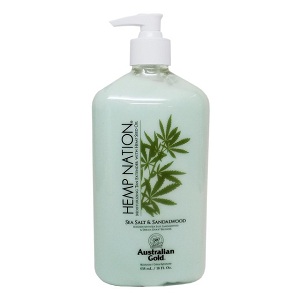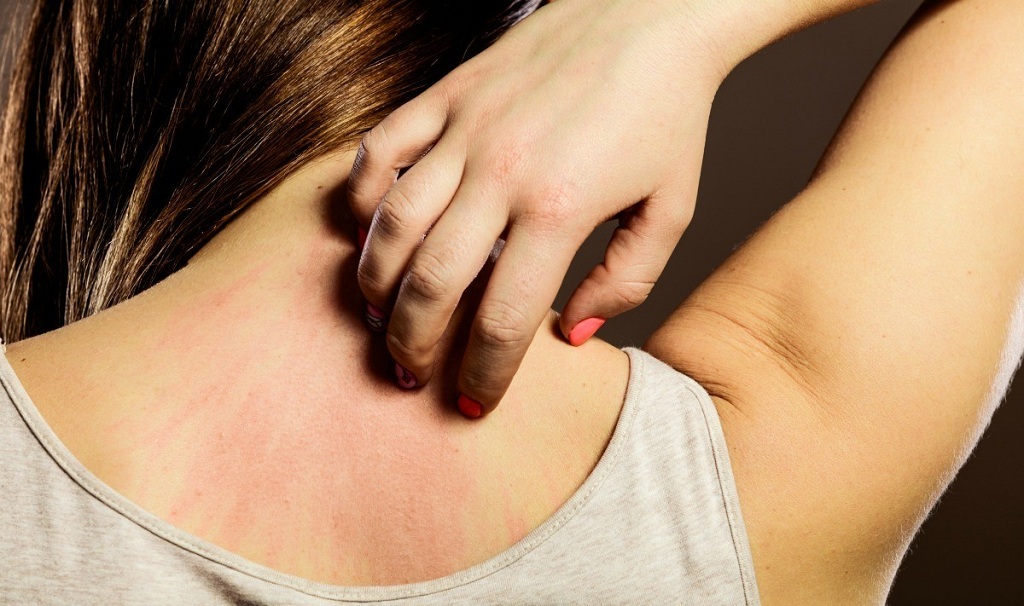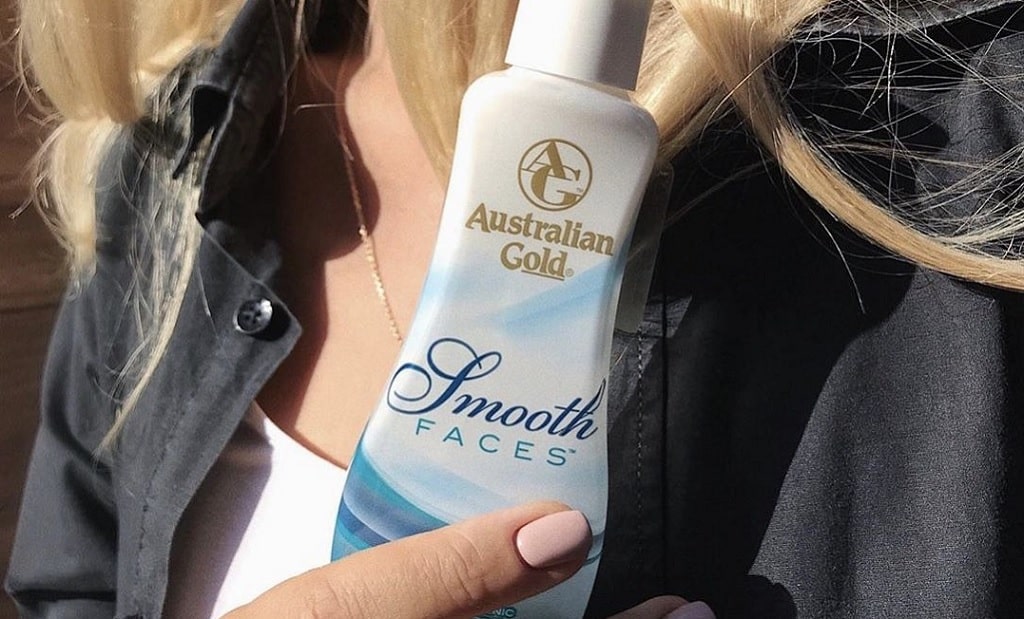As winter winds down, folks are building their base tans to get ready for summer. Along with the usual questions about how to tan, we’ve been hearing one inquiry more often. People want to know, “Why does my skin itch after tanning?”
That’s a good question with more than one possible answer. If you want to know why you’re itchy after tanning, read on.
What causes itching after tanning?
There’s more than one reason why you have itchy skin after tanning outside or after using a tanning bed.
Some people are allergic to sunlight – no joke. Too much UV exposure can cause bumpy skin and itchiness (1).
Certain medications (like antibiotics, antidepressants, and antifungals), essential oils (like bergamot), and herbal supplements (like St. John’s wort) make the skin sensitive to sunlight. They may make you more likely to burn or give you a rash and reaction to the UV rays.
Or you might be sensitive to the tanning lotion you’re using, your sunscreen, or even the chemicals used to clean the tanning bed. Sadly, if the tanning bed isn’t clean properly, the tanning itch could come from a fungal infection.
Furthermore, heat rash doesn’t just happen to babies. Adults get itchy, red, bumpy skin when sweat gets trapped against it.
The best bet is to stop tanning for a few days and consult with a doctor about your skin’s reaction. You might need to take an antihistamine or switch to fragrance-free skincare products.
We understand that not everybody has easy access to a dermatologist, so here are some other suggestions for what to do if you’re itching after using a tanning bed or laying out in the sun.
How do I stop itching after tanning?
How long does tanning itch last? Well, it depends on what causes the itch in the first place (see above). A heat rash that causes prickly skin after tanning might go away within a few hours or after a day if you can cleanse it with cool water and dab on some baby powder. But a fungal infection needs treatment and could drag on for some days (or weeks).
Really, the first step is simple: avoid the sun and avoid the tanning bed. If you must get bronzed, try a self-tanning product – but don’t apply it to irritated skin.
Next, soak in a lukewarm bath with oatmeal to hydrate and calm the skin. If you don’t have a tub, take a lukewarm shower and wash with mild soap, then put on lotion while your skin is damp to seal in the moisture. Don’t use a loofah or exfoliate. However, if it’s a prickly heat rash or fungal infection, use baby powder or cornstarch to soak up extra moisture. You don’t want to dry out your skin, just keep it from staying sweaty.
Another option is to apply an antihistamine cream, aloe vera, or a mild fragrance-free moisturizer. Some people find that ibuprofen helps with itching, too.
Benadryl’s anti-itch gel is a popular treatment for itchy skin after tanning because it doesn’t contain corticosteroids.
Benadryl Extra Strength Anti-Itch Gel

This antihistamine gel is safe for children aged 2 and up as well as adults. It calms itching related to sun exposure, poison ivy, and bug bites.
The active ingredient is 2% diphenhydramine hydrochloride which blocks the histamines that cause the itching. It’ll keep you from scratching your skin bloody and let you sleep at night, but it won’t make you drowsy.
The clear formula is transparent and doesn’t rub off on clothing or leave a chalky residue. Apply it up to four times per day.
How soon after tanning does the itching start?
It depends on what causes the itching – whether it’s UV exposure, heat, a fungus, or an allergic reaction. You might get itchy skin right away or tan a few times before your skin decides to freak out (2).
Expert tanners warn that you might notice a skin reaction sometime after your third session in a tanning bed, but it depends on how frequently and how long you tan. You can avoid problems by skipping a day or two between sessions to allow your skin to adjust. If you develop a rash, stay out of the tanning bed until it clears up. Then start back slow with a shorter, less intense session.
How to prevent tanning bed rash
Here are smart ways to avoid tanning bed rash. First, make sure your skin is well-moisturized before tanning. Use a professionally-formulated lotion like this one:
Ed Hardy Coconut Kisses Golden Tanning Lotion

Coconut Kisses is a best-selling indoor tanning lotion because it feels good on the skin, smells fabulous, and helps rapidly develop a deep, dark tan.
It contains no instant bronzers or self-tanning ingredients like DHA. Instead, it stimulates the body’s own pigment production with Melactiva, Melanobronze, Nouritan, and the Quad Tyrosine Blend. Reviewers say it intensely deepens color with fewer sessions.
Moreover, it leaves the skin velvety soft and lightly scented with coconut and vanilla. The formula prevents the typical after-tanning odor and keeps moisturizing for hours after it’s applied.
With nourishing ingredients like cocoa butter, coconut milk, and vitamin E, it also protects tattoo ink from fading.
Also, apply moisturizer before and after tanning outdoors. Dehydrated skin is itchy, and UV exposure plus heat robs the skin of moisture. Soothe your thirsty body with a cooling lotion so that it can develop a tan in peace.
Burt’s Bees Lotion Aloe & Coconut Oil After Sun Soother

There are many aloe gel after-sun products, but we love Burt’s Bees lotion because it’s packed with botanicals and doesn’t use scary chemicals like parabens or phthalates. The formula is 98.6% natural and certified cruelty-free. Plus, the manufacturer is carbon neutral and doesn’t contribute to landfills.
Check out the label. The first few ingredients are water, coconut oil, glycerin, and aloe. It has all the makings of a refreshing smoothie for the skin.
Users say it sinks in quickly and doesn’t feel greasy or sticky. The pleasant scent will bring a smile to your face while the lotion calms itching and stinging. If you put it on every day, it reduces peeling, too.
Keep your skin happy and hydrated to make your tan last longer.
Hemp Nation Sea Salt & Sandalwood Tan Extender

Here’s the secret to keeping your healthy glow as long as possible. It’s a tan extender lotion with DHA.
Dihydroxyacetone is the self-tanning ingredient in sunless tanning products. It can cover up white spots and camouflage vitiligo because it browns the surface of the skin. It doesn’t have anything to do with melanin which is why it works on the palest of skin. Even people who can’t tan can bronze with DHA.
A lotion like this one keeps the skin moisturized and keeps a natural tan from fading so quickly. Furthermore, it can help you build a gradual tan that looks completely natural but doesn’t require a tanning bed or time in the sun.
It features vitamins B5 and E to keep the skin young. But what you might value more is the fantastic fragrance. It’s a blend of sandalwood, coconut cream, rum, and citrus. Reviewers say it’s like a trip to the spa.
Speaking of the spa, before your next session it’s time to do a little investigation.
Ask staff at the salon what they use to clean the beds.
Tanning salons use antimicrobial spray that’s not supposed to give tanners a rash. It should prevent fungi and bacteria from infecting the next person in the bed. However, there’s always a small chance that it could irritate your skin. Ask to see the MSDS sheet or ingredients list.
Another option is to make sure the tanning bed is completely dry before you go inside. Try wiping it with a dry towel.
We’ve heard some people suggest wiping down the bed with an alternative cleaner, but this is risky because the wrong product may damage the acrylic. Discuss this with the tanning tech first.
Of course, using a tanning bed isn’t the only reason you might end up with itchy skin. It can happen even if you tan outdoors.
How to prevent itchy skin after tanning outdoors
Tanning outdoors is more unpredictable than a tanning bed. Not only do you have to allow for the UV level, but there are reflections from surfaces like the water that can give you sunburn even in the shade. Also, if it’s a windy day or you’re in a dry climate, you could end up with itchy, red skin faster than you expected.
The best way to successfully tan outdoors is to wear sunscreen. It doesn’t filter out one hundred percent of the UV rays so you can definitely still bronze. It just takes a little longer.
If you have pale skin and don’t want to wear sunscreen, try sunbathing before noon or after 4 PM for a half-hour at a time. Remember to apply lotion or tanning oil, and skip a day between sunbaths to give your skin time to develop a tan.
Seriously, wear sunscreen when you lay out in the sun. This is crucial protection for conditions like vitiligo as it can make the skin extra itchy after sun exposure. Plus, sunscreen adds a little extra moisture to keep the skin hydrated.
Reduce your risk of sunburn and suffering itchy skin after tanning by avoiding the time when the UV levels are high, like between noon and 4 PM.
Another option is to skip the sun altogether and self-tan. This extra-moisturizing lotion allows you to bronze gradually and enjoy a natural-looking healthy glow:
Beauty by Earth Self Tanner Tanning Lotion

If you have itchy skin, sometimes self-tanning products can make it even itchier. In our experience, wipes and mousse are the biggest culprits. Instead, try a gradual sunless tanning lotion with natural ingredients. This one is suitable for light to medium skin.
It’s rare these days to end up with orange skin because modern self-tanning formulas compensate for pH. You’re also unlikely to have streaky results as long as you follow the directions.
The easiest way to self-tan is to apply the lotion at bedtime. That’s because you don’t want to sweat or get wet for a few hours afterward. Also, avoid oily moisturizers as they can fade the color or make it patchy.
It takes a couple of days for this lotion to make a noticeable difference. But all that does is make your tan look more natural.
This formula doesn’t have a strong self-tanning odor and it’s made with clean ingredients. It’s paraben-free and has no artificial fragrance, making it good for sensitive skin.
We also appreciate the organic botanicals like aloe, shea butter, pomegranate, and green tea. They work to firm the skin and keep it hydrated and happy.
We hope this article has answered your questions about why skin itches after tanning and what to do about it. Here’s a quick summary of the products we suggested:
| The best products for preventing itchy skin after tanning | Why we love them |
|---|---|
| Benadryl Extra Strength Anti-Itch Gel |
|
| Ed Hardy Coconut Kisses Golden Tanning Lotion |
|
| Burt's Bees Lotion Aloe & Coconut Oil After Sun Soother |
|
| Hemp Nation Sea Salt & Sandalwood Tan Extender |
|
| Beauty by Earth Self Tanner Tanning Lotion |
|
Sources:
1. https://www.connecticutchildrens.org/health-library/en/teens/tanning-itch/ Is Tanning Making Me Itch? by Connecticut Children’s, updated January 14, 2015
2. https://www.leaf.tv/soothe-extreme-itching-after-tanning-9509.html How to Soothe Extreme Itching After Tanning, by Melissa King




